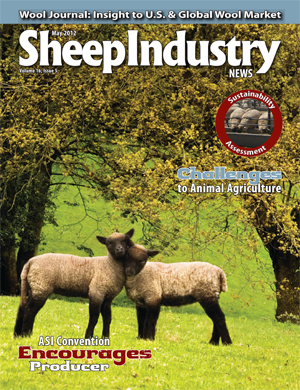Understanding the “Get Up and Go” of Lambs
(May 1, 2012) Industry researchers are now a step closer to understanding the “get up and go” of lambs at birth, which could help producers improve survival rates and their overall on-farm productivity.
By supporting new research through its postgraduate education program, the Cooperative Research Center for Sheep Industry Innovation (Sheep CRC) is looking at different ways to improve reproductive efficiency on Australia’s breeding properties.
Postgraduate researcher Rachelle Hergenhan recently studied the biology behind lamb vigour, or the “get up and go” of lambs at birth, which has been identified as an important trait for their subsequent survival.
“Some lambs will take a long time to stand after being born and won’t be very interested in finding the teat so would be considered to have low vigour,” Hergenhan said.
“Others will be trying to stand within a couple of minutes of birth, find the teat and be suckling within half an hour of being born, and so would be considered to be highly vigorous.”
She used the Sheep CRC’s support to research a more rigorous and accurate way to assess this behavioural characteristic as an indirect indicator of lamb survival.
“I felt that the way lamb vigour was assessed previously was quite subjective, and that there may be something learned by creating a much more consistent and standardized measure,” Hergenhan said.
Such a measure could be used experimentally to evaluate lamb vigour in sire progeny tests to investigate the genetic component of this trait, or it could be used in other studies to investigate “environmental” effects on the trait such as maternal nutrition.
“Traditionally, lamb vigour has been measured using the time it takes the lamb to first stand and suckle following birth,” she said.
“There are a series of behaviours that generally happen from the time the lamb is born until they first suckle, namely, shaking their head, balancing on knees, attempting to stand, standing and reaching the udder, and finally suckling.
“The aim of my thesis was to identify and evaluate other methods of assessing vigour and assessing it at a time when the ewe would normally be moving from the birth site, because this time is critical for the maintenance of contact between the ewe and the lamb.
“I felt that improving the ease of assessing lamb vigour may also provide a practical tool for improving lamb survival through genetic selection through a well-defined lamb vigour trait.”
New methods trialed included recording the physiological response of lambs to the placement of a temporary barrier between them and their mothers as well as to a short cold challenge at between four and six hours of age.
The rams used in the trial were selected from the Sheep CRC’s Information Nucleus flock on the basis of previously measured characteristics of their progeny with respect to vigour score and time taken to suckle.
Other factors likely to affect lamb vigour such as differences in late pregnancy nutrition and the breed of the ewe and ram were also recorded and assessed.
“I found that nutrition in late pregnancy had no effect on lamb vigour as measured by the time it took for the lamb to suckle,” Hergenhan said.
“The actual breed of the ram did not account for differences in lamb vigour, however within the same breed we found significant differences between rams in terms of the vigour of their progeny.
“There were high correlations between the vigour score measured for ram progeny groups and the time these lambs took to suckle. There was also a good correlation between vigour and the rectal temperature of lambs at 10 minutes of age.
“Using the temporary barrier test to assess the lambs’ ability to respond to ewe bleats at around three hours after birth, proved to be a useful method for assessing lamb vigour after the lamb has suckled. This test provides information on the capacity of the lamb to respond to the ewe at a time when she may be moving from the birth site.
“Interestingly, I found that the use of lamb vigour scoring as used in the Information Nucleus may be a useful selection method for identifying rams with the genes associated with improved lamb survival.”
Reprinted from Farm Weekly


